Volume 44 Number 1 (2013.3)
Special Feature
Organic Materials
Part I. Special Feature
Overview
Reviews
-
pages 1-15
Osamu Watanabe
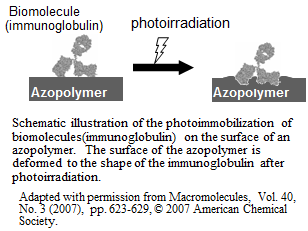
We introduce the principles of a newly created photoimmobilization technology using photoresponsive azopolymers and its background technology. The photoinduced immobilization is based on the deformation process on the surface of azopolymer. We applied this new technology to the immunochip which is made of immunoglobulin immobilized and a novel method to attain area-selective and controlled arrangement for colloidal crystals using the azopolymers.
-
3. Chemical Stability of Sensitizer Molecules for Dye Sensitized Solar Cells
 (1,369kB)
(1,369kB)pages 17-26
Hiromitsu Tanaka, Akihiro Takechi, Masahito Shiozawa, Naohiko Kato, Kazuo Higuchi, Shoichi Doi, Katsuyoshi Mizumoto and Tatsuo Toyoda
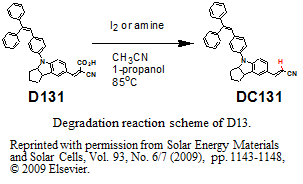
The chemical stability of sensitizer molecules for dye sensitized solar cells is reviewed. The interaction between the dye and its surrounding environment, such as TiO2 and electrolyte, is a factor determining the durability of the DSC cell. Our study on the organic dye D131 reveals that degradation of the dye is promoted by iodine and amine in the electrolyte and the decomposition product is decarboxylated D131 (DC131), which is liberated from the electrode and lowers the cell efficiency.
Research Reports
-
4. Atomistic and Mesoscopic Simulations for Polymer Materials
 (285kB)
(285kB)pages 27-33
Satoru Yamamoto
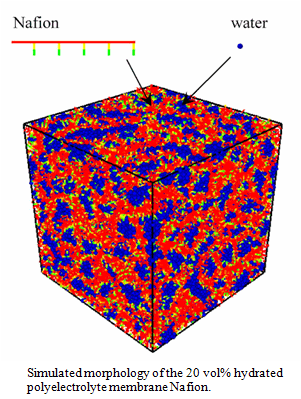
A molecular dynamics simulation was performed to investigate the CO2 induced plasticization of a polyetherimide. A mesoscopic simulation method, the dissipative particle dynamics (DPD), was applied to study the relaxation mechanism of surfactant threadlike micelles, and the mesoscopic structure of the polyelectrolyte membrane Nafion. A novel method to simulate evaporation process of polymer solution was proposed using the DPD.
-
pages 35-43
Kenichi Hayashida
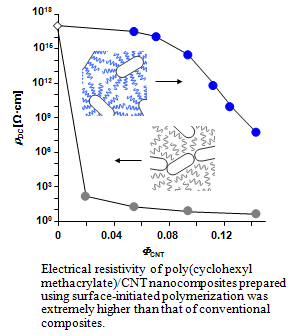
Poly(cyclohexyl methacrylate)-grafted carbon nanotube (CNT) composites prepared using surface-initiated polymerization showed extremely higher electrical resistivity than conventional polymer/CNT nanocomposites. This excellent property is achieved by the perfect isolation of the individual CNTs in the densely-grafted high-molecular-weight polymer matrix.
-
pages 45-52
Kenzo Fukumori, Takuya Morishita, Mitsumasa Matsushita and Yoshihide Katagiri
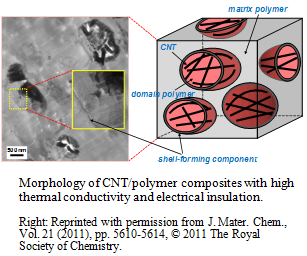
Carbon nanotubes (CNTs) with extremely high thermal conductivity have attracted much attention as noticeable nanofiller candidates to improve thermal conductivity of polymers. We designed and fabricated CNT/polymer composites at low concentrations (less than 1 vol%) of CNTs having a novel morphology with high thermal conductivity and electrical insulation.
Part II. Highlighted Paper
Research Report
-
7. Linear and Singular Response to Weak Perturbation in Overdamped Systems
 (446kB)
(446kB)pages 53-59
Akihisa Ichiki, Yukihiro Tadokoro, Masaki Takanashi and Mark I. Dykman
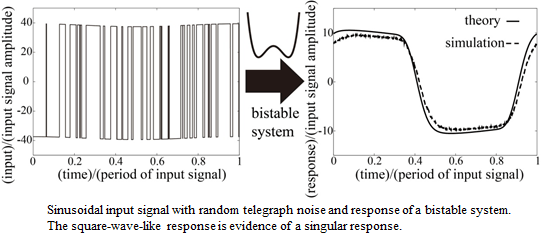
We investigate the enhancement of the response to a weak perturbation observed in two types of systems: an overdamped system driven by a high-frequency external force, which is analyzed by linear response theory, and an overdamped system with random telegraph noise, the response of which requires a renormalization approach for analysis. We demonstrate that the enhancement of the response originates from a bifurcation phenomenon.
